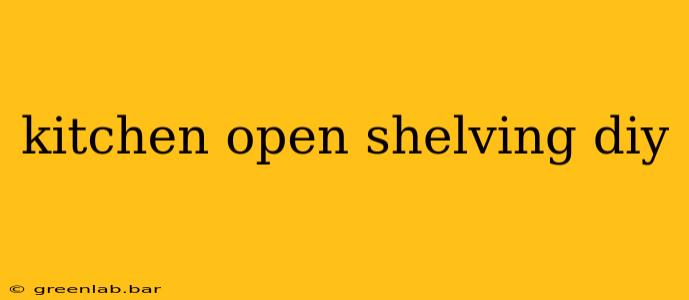Open shelving in the kitchen is a fantastic way to add character, display your favorite dishes, and create a sense of spaciousness. But the cost of professionally installed open shelving can be prohibitive. This guide provides a comprehensive, step-by-step approach to building your own DIY kitchen open shelving, saving you money and allowing you to customize the look to perfectly match your kitchen style. We’ll cover everything from planning and materials to installation and styling tips.
Planning Your DIY Kitchen Open Shelves
Before you even think about grabbing a saw, careful planning is crucial for a successful project. This stage will determine the final look, functionality, and overall success of your DIY open shelving.
1. Measuring and Design:
- Determine Shelf Placement: Consider the existing layout of your kitchen. Where do you want the shelves? Above the countertop? Near the stove? Think about what you'll be storing on each shelf and plan accordingly. Measure the available wall space precisely.
- Shelf Dimensions: Decide on the number of shelves, their depth (typically 10-12 inches), and width. The width should be proportionate to the wall space and the items you intend to store. Consider using multiple shorter shelves rather than one long, heavy shelf.
- Shelf Material: Select your material. Pine is a popular and affordable choice, offering a good balance of strength and ease of working with. Other options include hardwood (like oak or maple for a more premium look) or even reclaimed wood for a rustic aesthetic.
2. Choosing the Right Hardware:
- Shelf Brackets: The type of brackets you choose will significantly impact the look of your shelves. Consider floating shelves for a minimalist look, or use traditional brackets for a more rustic or industrial style. Measure the shelf thickness to ensure compatibility with your chosen brackets. Ensure the brackets are rated for the weight you intend to place on the shelves.
- Screws: Use screws appropriate for your wall type and shelf material. Drywall anchors are essential if you're installing shelves on drywall.
Gathering Materials and Tools
Once you have your plan finalized, gather all the necessary materials and tools. This will streamline the process and prevent interruptions.
Essential Materials:
- Wood: Cut to your desired dimensions (consider having your lumber yard cut it for you).
- Shelf Brackets: Choose a style and quantity to match your design.
- Screws: Appropriate for both the brackets and the wall type.
- Wall Anchors (if needed): Essential for drywall installations.
- Wood Stain or Paint (optional): To customize the look of your shelves.
- Sandpaper: For smoothing out the wood before staining or painting.
Essential Tools:
- Measuring Tape: For accurate measurements.
- Level: Crucial for ensuring your shelves are straight.
- Drill: With appropriate drill bits for your screws and wall type.
- Stud Finder: To locate wall studs for secure installation.
- Pencil: For marking bracket and shelf placement.
- Safety Glasses: Always prioritize safety.
- Sanding Block or Sander: For a smooth finish.
Installing Your DIY Kitchen Open Shelving
With your plan and materials ready, follow these steps for a professional-looking installation.
1. Locate Studs:
Use a stud finder to locate wall studs. Securing shelves directly to studs provides the strongest and most reliable installation.
2. Mark Bracket Locations:
Use a level and pencil to mark the locations for your brackets on the wall, ensuring they are evenly spaced and level.
3. Pre-Drill Holes (if necessary):** This prevents wood from splitting.
4. Install Brackets:
Securely attach the brackets to the wall using the appropriate screws and wall anchors (if needed).
5. Install Shelves:
Carefully place the shelves onto the brackets, ensuring they are level and secure.
6. Finishing Touches:
Sand, stain, or paint the shelves according to your desired aesthetic. Allow ample drying time before adding items.
Styling Your DIY Open Shelving
Now that your beautiful DIY open shelving is installed, it’s time to style it!
- Organize Functionally: Group similar items together for a cohesive look.
- Visual Appeal: Vary heights and textures of items for visual interest.
- Highlight Favorite Pieces: Showcase your best dishes or decorative items.
- Maintain Balance: Avoid overcrowding the shelves. Leave some negative space for a clean look.
With a little planning, effort, and these step-by-step instructions, you can create stunning, custom kitchen open shelving that enhances your kitchen's style and functionality. Remember to prioritize safety and take your time; the result will be well worth it!

